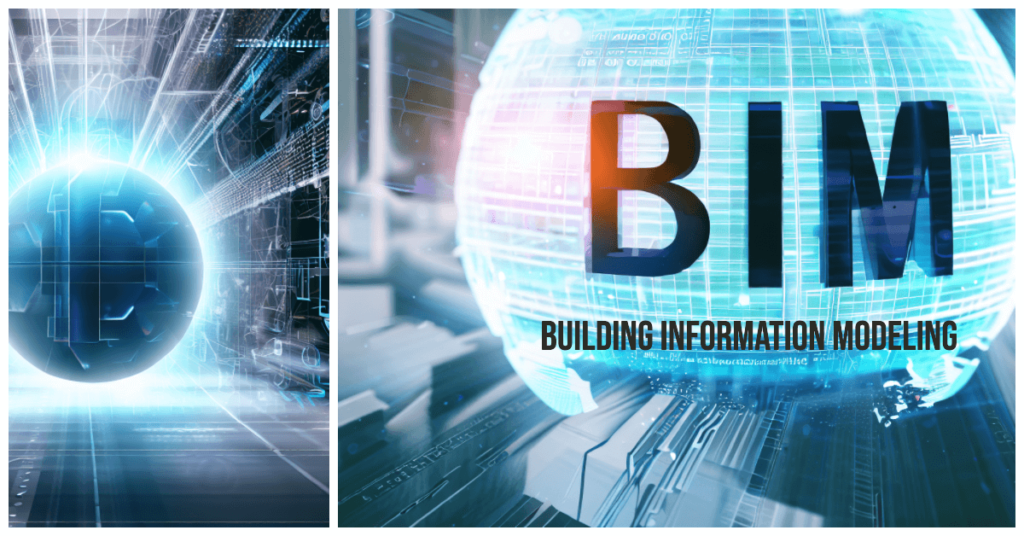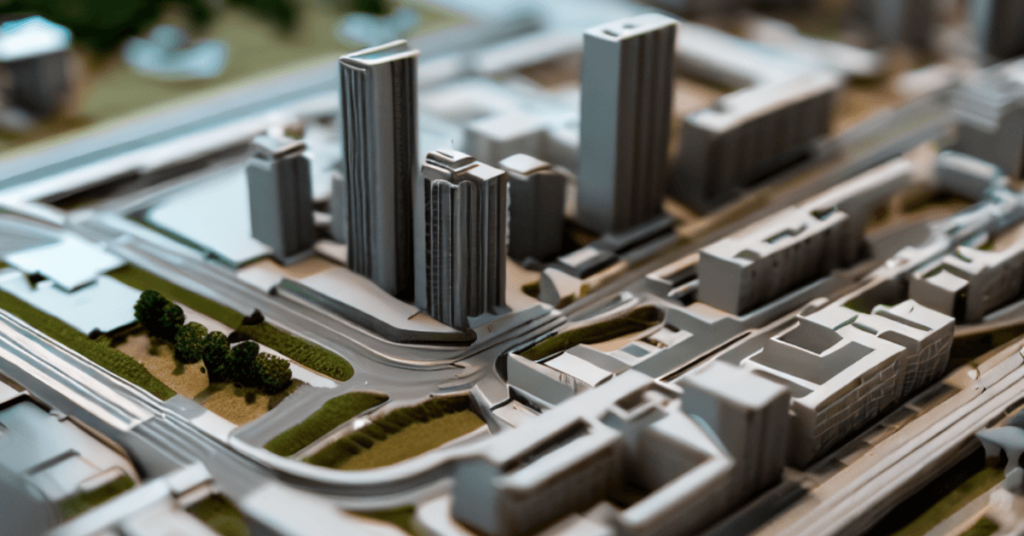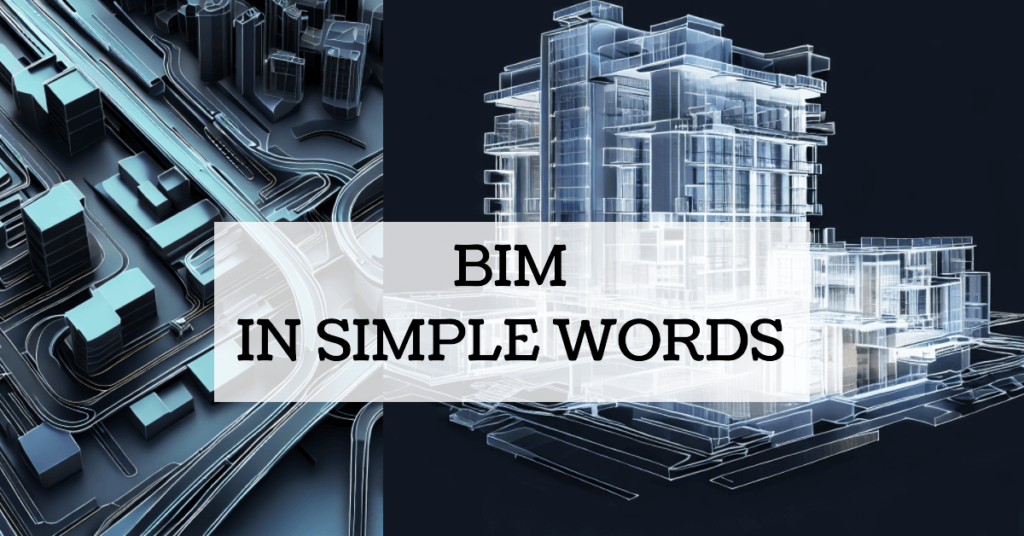Are you a civil engineering professional, an AutoCAD draftsman, a civil engineering student, or an architectural designer looking to grasp the basics of Building Information Modeling (BIM)? You’ve come to the right place. In this comprehensive guide, we’ll take you through the ins and outs of BIM, providing you with a solid foundation in this transformative technology.
What is BIM Full Form
The full form of BIM is “Building Information Modeling.“What is BIM?

Building Information Modeling (BIM) is a revolutionary approach to designing, constructing, and managing buildings and infrastructure. Unlike traditional 2D drawings, BIM digitally represents a building’s physical and functional characteristics. This digital model is a collaborative hub, encompassing everything from architectural plans to structural details, plumbing systems, electrical layouts, and more.
Let’s break down the term;
Building: The “B” in BIM stands for “Building,” but it doesn’t only apply to structures like houses and skyscrapers. It encompasses all infrastructure, from bridges and roads to tunnels and dams. Essentially, anything that involves construction can benefit from BIM.
Information: The “I” is for “Information,” and this is where the magic happens. BIM involves creating digital models of a building or infrastructure project that contain an incredible amount of data. This data isn’t just about how things look but also how they work. For example, a BIM model of a building will include information on its materials, dimensions, electrical systems, plumbing, and even how it responds to changes in temperature or other environmental factors.
Modeling: The “M” stands for “Modeling.” Imagine creating a virtual version of a building or structure on a computer. This digital model is like a highly detailed, 3D blueprint that allows engineers and architects to visualize every aspect of the project. It’s not just a static image; it’s a dynamic representation that can be manipulated and analyzed in countless ways.
BIM in Layman’s Terms
Imagine you’re building an intricate LEGO structure. You have different pieces – some small, some big – and you want to ensure they fit together perfectly. But how can you be sure? That’s where Building Information Modeling, or BIM for short, comes into play. It’s like having a super cool LEGO planner for actual buildings!
BIM is an intelligent way of making buildings and structures using computers. Instead of just drawing pictures of buildings, like you might do in art class, architects and engineers use special computer programs. These programs help them create a 3D digital model of a building. This digital model is like a super detailed blueprint. It’s not just about how the building looks from the outside; it’s about what’s inside, too – like where the plumbing goes, how the electricity works, and even how the air conditioning keeps things cool.
Here’s why BIM is awesome:
1. Everything Fits Together: With BIM, you can ensure all the pieces fit perfectly, just like LEGO bricks. This means fewer mistakes when building real structures.
2. Teamwork: BIM is like a big online playground where architects, engineers, builders, and even those who use the building can work together. They can see the digital model and make suggestions so everyone’s on the same page.
3. Easy Changes: If you want your LEGO castle to have an extra tower or your real building to have more rooms, BIM makes it easy to change the plans without starting from scratch.
4. See Before You Build: With BIM, you can “walk through” the digital model like a video game. This helps you understand how the building will look and work before it’s even built.
5. Less Wasted Stuff: BIM helps save materials and energy. This is great for the environment because it means less waste and a smaller carbon footprint.
Consider BIM a super smart way to plan and build amazing structures. It’s like having a digital LEGO set for grown-ups, ensuring everything fits perfectly and everyone can work together to create something incredible!
Navigating the BIM Workflow: Simplified for Aspiring Engineers

Understanding the BIM (Building Information Modeling) workflow is crucial for young engineering enthusiasts. Let’s begin this journey by breaking down complex concepts into digestible, straightforward terms.
The Evolution of Architectural Collaboration
Centuries ago, architectural teams comprised architects and engineers who would sit down with a cup of coffee, a pen, and paper to discuss and devise intricate designs. Fast forward to today, and architectural teams have transformed dramatically. They now include owners, developers, architects, structural engineers, MEP (Mechanical, Electrical, and Plumbing) engineers, general contractors, subcontractors, city code experts, security specialists, certification authorities, and more. Each member of this diverse team wields specialized software tailored to their role.
The Email Quandary
In this technologically advanced 21st century, architects and engineers attempt to collaborate primarily via email. Countless emails zip through cyberspace daily, and the inbox constantly overflows. The challenge lies in deciding which information to share, with whom, and when. Reading through this deluge of emails is a Herculean task, and pertinent information often slips through the cracks. Mismatches between email subject lines and actual discussions can lead to confusion.
BIM: Bridging Communication Gaps
Enter BIM, the game-changer. BIM facilitates seamless communication, ensuring that information reaches the right hands without getting lost in the digital abyss. BIM’s core revolves around the “Common Data Environment” or the BIM platform. These cloud-based platforms are multifaceted, managing user access, hosting various file formats, and often integrating 3D BIM model viewers. The Common Data Environment acts as a virtual BIM bubble, ensuring that every stakeholder remains connected and has access to essential project data.
More Than Data Sharing
While BIM’s essence lies in information sharing, it extends beyond that. Naturally, concerns arise regarding legalities, insurance, and intellectual property rights. Protecting drawings, studies, and source files is a common instinct. Different countries tackle these issues in unique ways, and it’s advisable to seek guidance from professionals in your network.
The Utopian Vision of BIM
In an ideal world, BIM fosters a collaborative spirit akin to parents navigating co-parenting after a divorce. While differing opinions may exist, the common goal of delivering an exceptional project unites the team. Changing entrenched habits takes time, but trust and collaboration can yield tremendous benefits through BIM.
The BIM workflow is about simplifying communication, breaking down silos, and enhancing collaboration among the many players in the construction industry. Embracing BIM is akin to embracing the future of construction, one that promises efficiency, accuracy, and a brighter tomorrow for young engineering minds.
Unpacking BIM: The Three M’s Simplified
Let’s unravel the acronym “BIM,” which is pivotal in engineering and construction. If you are an engineering enthusiast, understanding BIM can be as easy as ABC.
Breaking Down BIM: Building Information Modeling
At first glance, BIM seems pretty straightforward. “Building Information” – those first two words are crystal clear. Now, let’s talk about the enigmatic “M.” It could stand for Model, Modeling, or Management. In reality, it encompasses all three. Let me introduce you to the “Three M’s of BIM.”
M #1: Building Information Modeling (BIM)
Officially, BIM stands for “Building Information Modeling.” This is where the magic begins, as BIM is fundamentally a process. It’s about sharing comprehensive information about a building project, and it also outlines the game plan for implementing the Common Data Environment (CDE). Think of it as the backbone that supports the entire project.
M #2: Building Information Model
Now, let’s delve into the second “M” – “Building Information Model.” This is the tangible part, the digital representation of the physical building. You’ve probably heard it referred to as a “3D BIM Model.” But here’s the twist: it’s not just a 3D shape; it’s a 3D shape enriched with data. That’s what sets it apart. It’s the brainy twin of the traditional 3D model.
3D Model vs. 3D BIM Model: Here’s the key difference. A regular 3D model is like a sculpted figure, visually appealing but devoid of intelligence. On the other hand, a 3D BIM model is a smart fusion of objects and information. It’s a harmonious blend of 3D shapes and their corresponding data. Not all software can create these intelligent models, so the choice of software matters.
M #3: Building Information Management
Lastly, we arrive at the third “M” – “Management.” While this term might be relatively new to the construction industry, it’s an age-old concept in various other fields. Management in BIM ensures that the entire process flows seamlessly, without hiccups or conflicts of interest. The human touch fosters collaboration among all project stakeholders, ensuring everyone works in harmony for the project’s greater good.
The Holistic BIM Experience
So, here’s the crux of BIM: it’s not just about software; it’s about the three M’s working in harmony. Without a 3D model, there’s no BIM. Everyone agrees on that. But equally crucial is the sharing of the 3D BIM model through a standardized process on a collaborative platform, all under the watchful eye of a BIM manager. That’s the true essence of BIM—a comprehensive approach encompassing Modeling, Model, and Management.
BIM is your passport to the future of engineering and construction. It’s a multidimensional concept that empowers you to create, manage, and collaborate on projects like never before. Understanding the Three M’s of BIM is your first step toward unlocking its endless possibilities.
Where BIM Gets to Work:
- Homes: BIM comes into play when someone wants to build a new house. It helps design how many rooms there should be, where windows go, and even how the plumbing works. Your dream home might have a bit of BIM magic in it.
- Skyscrapers: Those super tall buildings you see in big cities? BIM helps create them, too. It’s like a giant puzzle, and BIM ensures all the pieces fit together safely, even way up in the sky.
- Bridges and Roads: BIM isn’t just for buildings. It’s also used to design bridges and roads. It helps ensure they’re strong, safe, and don’t fall apart. So, when you drive over a big bridge, remember there’s some BIM magic keeping you safe.
- Factories and More: BIM can be used for various things, like designing factories, airports, and even theme parks. It helps plan out where everything goes, so it’s super organized and efficient.
- And every construction project….
BIM is like a super-duper building tool that helps grown-ups design and build amazing things without mistakes. It makes homes, skyscrapers, bridges, and even cool places like theme parks. BIM is like a superhero team, making sure everything is just right, and it can work its magic anywhere in the world. So, the next time you see a fantastic building or bridge, you’ll know BIM made it awesome!
Why BIM Matters

Streamlined Collaboration
BIM is like teamwork on steroids. Imagine you and your friends building the most epic treehouse ever. With BIM, architects, engineers, and builders can work together efficiently. They all use special computer programs to create and share their ideas. It’s like having a digital playground where everyone can see and add to the fun!
BIM promotes collaboration among professionals in various disciplines. Architects, structural engineers, civil engineers, and other stakeholders can work together seamlessly on a single, shared platform. This collaboration ensures everyone is on the same page, reducing errors and improving project efficiency.
Enhanced Visualization
One of BIM’s standout features is its ability to provide 3D visualizations of a project. This not only aids in design but also makes it easier for clients and team members to understand the project’s intricacies.
Have you ever tried building a puzzle without seeing the picture on the box? It’s tough! But BIM lets architects see their buildings in 3D before they’re even built. It’s like playing with a digital model of the real thing. This helps them spot mistakes and make everything just right. No more surprises when the treehouse is almost finished!
Data-Driven Decisions
Money and time are precious. BIM can save a lot of both. It’s like having a magical calculator that tells you how much everything will cost and how long it will take to build. Architects can make smart choices to keep projects on budget and on time. So, more epic treehouses for everyone!
BIM doesn’t just handle design; it also manages data. Every element in the digital model contains valuable information, from cost estimates to material specifications. This data can inform critical decisions throughout a project’s lifecycle, from initial planning to maintenance and renovations.
Sustainability and Efficiency
BIM can help achieve sustainability goals by simulating the environmental impact of design decisions. This can lead to more eco-friendly building designs and reduced resource consumption.
How BIM Works:

Have you ever wondered how the world’s most amazing buildings, like the tallest skyscrapers or the coolest stadiums, come to life? It’s not just about bricks and cement; it’s about something called Building Information Modeling, or BIM. Let’s dive into this magical blueprint for buildings and see how it all works!
The Core Principles of BIM
Okay, let’s start with the basics. BIM has some core principles, like the rules of a cool club. First, it’s all about teamwork. Imagine you and your friends building the best treehouse ever. You need to work together and plan things out, right? BIM does the same thing but with architects, engineers, and builders. They all team up to create awesome buildings.
Next, BIM is like a time machine for buildings. It helps you see what a building will look like before it’s even built! It’s like drawing a picture of your treehouse before you build it, but it’s way fancier.
Principles of BIM
We’ll break it down into simple words and even explore BIM’s particular principles!
Principles of BIM: Level
Think of BIM levels like a game with different stages. Each level represents how much information and magic a BIM model holds.
- Level 0: Basic Drawings
At this level, it’s like having a drawing on paper. Architects and builders use simple pictures to show their ideas, like a treasure map sketch. - Level 1: Adding Depth
Now, we’re adding a bit of magic. Builders use computers to create 3D models, making buildings look more real. It’s like turning your 2D drawing of a tree into a 3D treehouse. - Level 2: Teamwork Time
This is where things get exciting! Architects, engineers, and builders join forces. They share their 3D models on computers and work together, like superheroes teaming up to save the day. - Level 3: Time Travelers
Imagine having a time machine! Level 3 BIM lets builders see how a building changes over time. They can watch it grow, like a plant growing from a tiny seed into a tall tree.
Principles of BIM: Dimensions
Now, let’s dive into the dimensions. It’s like seeing things from different angles:
- 2D: Flat World
Think of it like reading a storybook with pictures on each page. Architects use 2D drawings to show what a building looks like from above, like a bird’s-eye view. - 3D: Adding Depth
Now the storybook has pop-up pictures! Architects create 3D models that show how tall a building is, like seeing a skyscraper rise into the sky. - 4D: Time Travelers
This is where the storybook becomes magical. Builders use 4D to see how a building changes over time, like flipping through pages to watch a plant grow. - 5D: Counting Coins
Picture this as a treasure hunt. Builders use 5D to count the gold coins they need to build a project. It helps them make sure they have enough money. - 6D: Earth Heroes
Here, buildings become Earth’s heroes. 6D BIM helps builders create eco-friendly structures that are kind to our planet. It’s like turning buildings into Earth’s friends.
Principles of BIM: LOD
LOD is like a secret code for how detailed and smart a BIM model is:
- LOD 100: The Beginner
Imagine drawing a stick figure. This is where we start, with basic shapes that show what something looks like. - LOD 200: Adding Some Detail
Now we give our stick figure some clothes and features. Architects add more details to their models. - LOD 300: Getting Smart
Our stick figure becomes super smart. Builders add information like sizes and materials, making the model even more helpful. - LOD 400: Almost Real
It’s like making a doll that looks like a real person. Builders create models that are almost as good as the real thing. - LOD 500: The Real Deal
Finally, we bring our doll to life! Builders create models exactly like the real building, with every detail you can imagine.
So, my young adventurer, you’ve now uncovered the secrets of BIM principles. It’s like discovering a treasure map that leads to amazing buildings and a world of possibilities. With BIM, architects and builders can work together, create magical 3D models, and even travel through time—all while making our planet better. Happy exploring!
BIM Software and Tools

Here’s where the magic happens – with special computer programs and tools. Architects and builders use BIM software to create their digital blueprints. It’s like using a drawing app but for buildings. They can design every detail, from the roof to the floors.
BIM tools also help with teamwork. Everyone can see and discuss the same plans, like using a group chat for your treehouse project. This way, there are fewer mistakes, and the building comes out just as they imagined it.
In the fascinating world of Building Information Modeling, or BIM for short, architects, engineers, and builders have a set of amazing digital tools that help them create, design, and manage buildings in the most magical way possible. Imagine having a toolbox filled with digital wonders that make construction projects easier and more exciting!
1. AutoCAD: Picture AutoCAD as a digital drawing board where architects and draftsmen sketch out their ideas. It’s like having a super-smart pencil and ruler that lets them create detailed 2D and 3D designs of buildings.
2. Revit: Revit is like a digital LEGO kit for architects and engineers. It’s fantastic for creating 3D models of buildings. What’s really cool is that if you change something in one part of the model, Revit automatically updates everything else that depends on it. It’s like magic!
3. Navisworks: Think of Navisworks as a pair of X-ray glasses for buildings. It allows professionals to see inside 3D models and make sure everything fits perfectly. This helps prevent problems during construction and keeps everything running smoothly.
4. SketchUp: SketchUp is like a 3D doodling pad. Architects and designers can quickly sketch out their ideas and turn them into stunning 3D models. It’s like turning your imagination into digital art!
5. BIM 360: When teamwork is essential, BIM 360 is like the conductor of an orchestra. It’s a cloud-based platform that helps teams work together, share designs, and keep projects organized and on track. Everyone can play their part and create harmony in construction.
6. Rhino: Rhino is like a digital sculptor’s toolkit. It’s used to create complex 3D shapes and designs. Architects and artists use it to bring unique and creative ideas to life. It’s where imagination meets technology!
7. Solibri: Solibri is like a building inspector’s superhero sidekick. It checks 3D models for errors and makes sure everything follows the rules. This way, we can be sure that buildings are safe and sound, just like in a superhero movie.
8. Bluebeam Revu: Bluebeam Revu is like a digital notebook for builders. It helps with reviewing and marking up plans, which is like jotting down notes on a blueprint. It keeps everything organized and ensures everyone is on the same page.
9. Trimble SketchUp Viewer: Imagine having a magical window to your building design. This tool lets you view 3D models on your phone or tablet and explore them from every angle. It’s like having a miniature virtual building in your pocket!
10. Trello: When you need to organize tasks and schedules, Trello is like a digital to-do list that keeps everyone on the same page. It’s like a magical task manager that makes sure everything gets done.
These are just some of the incredible tools that architects, engineers, and builders use in the world of BIM. Each tool has its own special powers, and when they work together, they create amazing buildings, bridges, and structures that make the world a more exciting place!
BIM in Architecture
BIM (Building Information Modeling) is like your superhero tool belt, full of amazing gadgets to help you create those awesome structures!
BIM’s Role in Architectural Design: BIM is like your design sidekick. It helps you create digital models of buildings that are super detailed and smart. You can think of it as a 3D blueprint that has extra brains. With BIM, you can plan every little detail of a building before it’s even built. It’s like knowing the whole story before you start drawing the pictures.
Using BIM for Conceptual Design and Planning: Now, imagine you’re coming up with an idea for a brand-new building. BIM is like a giant sketchbook where you can turn your ideas into 3D models. It’s like building a Lego castle in your imagination and seeing how it looks from all angles. This helps you figure out if your ideas will work in the real world.
BIM in Civil Engineering – Building Cool Stuff the Smart Way!

Here are some uses of BIM in Civil Engineering
1. BIM Applications in Civil Engineering Projects: Consider BIM a super-smart computer game for engineers and architects. It helps them plan and design things like roads and bridges on the computer before building them in real life. It’s like making a digital version first to check if everything will work perfectly. No more “Oops!” moments!
2. Road Design and Infrastructure Using BIM: Have you ever seen a winding road through the mountains? BIM helps engineers create those. It’s like playing with a digital racetrack but with real cars! BIM makes sure the roads are safe and smooth to drive on. And when they build new bridges, BIM helps them see if they’ll stay strong during storms.
3. BIM for Environmental Impact Assessment: We love our planet, right? BIM helps engineers check how new projects might affect the environment. It’s like being an eco-hero! They can see if building something new might harm nature or water sources and find ways to protect them. So, it’s like building cool stuff while being kind to the Earth.
Common BIM Terms and Concepts: Decoding the BIM Lingo

BIM, or Building Information Modeling, might sound like a complex jigsaw puzzle, but don’t worry; we’re here to clarify it. In the world of BIM, there’s a unique language you’ll want to know, some key concepts to wrap your head around, and guidelines to keep everything in line.
Understanding BIM Terminology:
Just like every field has its jargon, BIM has its unique words. Let’s break down some common ones:
- Model: This is like the digital blueprint of a building or structure. It’s a 3D representation that’s packed with information.
- Parametric: Imagine you have a 3D shape and can change its size or shape by just typing in some numbers. That’s parametric modeling – it’s like magic!
- Clash Detection: Think of this as the superhero power of BIM. It checks if different parts of a building, like pipes and walls, will bump into each other when it’s built. If they do, it’s a “clash,” and BIM helps solve it.
Key Concepts: LOD, Clash Detection, and Parametric Modeling:
Now, let’s zoom in on these concepts:
- LOD (Level of Development): This is like saying how detailed and complete your digital model is. If it’s at LOD 100, it’s like a basic sketch. At LOD 500, it’s super-detailed, with all the nuts and bolts.
- Clash Detection: BIM software can spot clashes or problems before they happen in real life. Think of it as finding and fixing issues in a video game before you hit a wall.
- Parametric Modeling: Imagine you’re designing a chair in 3D. With parametric modeling, you can easily change its height, width, or color by adjusting some settings. It’s like having a super-flexible design tool.
BIM Standards and Guidelines:
Just like traffic rules keep roads safe, BIM has standards and guidelines to keep things running smoothly. These rules ensure everyone in the BIM world speaks the same language and follows best practices. It’s like having a playbook for a winning team.
So, there you have it! BIM has its language, like model, parametric, and clash detection. You’ll also dive into cool concepts like LOD, which measures your digital model’s details, and parametric modeling, which lets you be a digital design wizard. And don’t forget the rules of the game – the standards and guidelines that keep everything humming along in the world of BIM. Now, you’re well on your way to mastering the BIM universe!
BIM Implementation: Bringing the Digital Revolution to Construction

Picture this: You’re on a mission to bring the future of construction to life. That’s exactly what BIM, or Building Information Modeling, is all about. But how do you make it happen? Let’s break it down step by step.
Steps to Implement BIM in Projects:
Think of implementing BIM like building a skyscraper. It’s a process, and here are the main steps:
- Define Your Goals: First, you need to know what you want to achieve with BIM. Are you aiming for better designs, fewer errors, or cost savings? Define your goals clearly.
- Get the Right Software: BIM runs on specialized software. Choose the one that fits your needs best. It’s like picking the perfect tool for the job.
- Training Is Key: Just like learning to drive a car, you need to train your team to use BIM software effectively. Training programs and certifications can help your team become BIM pros.
- Start Modeling: Once your team is trained, it’s time to create 3D digital models of your projects. These models hold all the information you need, from design details to construction schedules.
- Collaborate and Communicate: BIM is all about teamwork. It allows different teams to work together smoothly. It’s like an orchestra playing in perfect harmony.
- Monitor and Improve: Keep an eye on how BIM is working for you. Are you meeting your goals? If not, make adjustments and improvements.
Overcoming Challenges in BIM Adoption:
Just like any big project, there are challenges in adopting BIM. Here’s how to tackle them:
- Resistance to Change: Some team members might be resistant to new technology. Explain the benefits and provide support to ease the transition.
- Cost and Training: BIM software and training can be costly. Consider the long-term benefits and invest wisely.
- Data Management: BIM generates a lot of data. Managing it efficiently is crucial. It’s like organizing a massive library so you can find the right book instantly.
BIM Training and Certification:
Imagine BIM training as learning a new language. It’s essential to speak BIM fluently. Training programs and certifications, like getting a driver’s license, ensure your team knows the ropes. They become skilled in using BIM software, interpreting digital models, and collaborating effectively.
Real-World BIM Examples: Transforming the Construction Landscape

Exploring Real-World BIM Examples: A Global Perspective
To demystify Building Information Modeling (BIM) for budding engineers, let’s delve into real-world applications that provide insights in a language tailored to a 20-year-old engineering student. BIM is more than just a buzzword; it’s a game-changer in construction and design.
BIM Experience Around the World
Are you wondering if BIM is genuinely revolutionizing the construction landscape worldwide? Let’s take a closer look at how countries across the globe are not only adopting but often mandating BIM for their construction projects.
BIM in Action: Countries Leading the Way
Starting in Northern Europe in the late 2000s, BIM gained substantial traction, aided by strong governmental support. By 2010, Northern European countries began implementing BIM requirements for building projects, making BIM an essential component of the construction process. In Singapore, they took a giant leap forward by making it mandatory for any project exceeding 5,000 square meters to submit permit applications using the BIM process, a significant stride towards efficiency and accuracy.
The United Kingdom’s BIM Revolution
The United Kingdom embarked on a BIM journey in 2007, with the government and the British Standards Institution shaping BIM guidelines. These guidelines continuously evolve, drawing from the experiences of real BIM projects. The UK’s ambitious construction strategy aims to achieve a remarkable 20% reduction in procurement costs. Furthermore, they announced that all public projects would be required to use BIM by 2016, providing the industry with ample time to adapt. These government initiatives encouraged private owners to incorporate BIM into their projects. Today, more than 60% of the UK building industry relies on BIM.
The U.S. BIM Landscape
While the United States played a significant role in the early development of BIM around 2005, progress has been somewhat fragmented. The introduction of the National BIM Standards of the United States aimed to provide guidance and standards for the industry, but BIM adoption varies widely by region. Depending on the area, 40% to 75% of public and private projects utilize BIM. Certain states, such as Wisconsin, have mandated BIM for public projects. While BIM is now a requirement for major federal projects, it hasn’t yet permeated all aspects of construction. However, smaller public institutions like the General Services Administration, the US Army Corps of Engineers, and the Naval Facilities Engineering Command have embraced BIM.
A Global Shift Towards BIM
Beyond the UK and the US, countries like Canada, Australia, and New Zealand have adopted BIM guidelines and standards, even though they lack strict regulations. Owners, public and private contractors, and architects worldwide recognize the transformative potential of BIM, with 50% to 75% of them integrating it into their projects. The global consensus is clear: BIM is not a passing fad; it’s a tangible reality. Many countries are embracing this new approach, fostering superior design, construction, and management practices. The message is loud and clear – prepare for the BIM revolution or risk falling behind in a highly competitive field.
The Future of BIM: Pioneering Construction’s Digital Revolution

As a budding engineering student, you’re stepping into a world where technology and innovation continually redefine what’s possible. BIM, or Building Information Modeling, is no exception. Let’s glimpse the crystal ball and explore what lies ahead in BIM.
Emerging Trends in Building Information Modeling: BIM is evolving at a lightning pace. One exciting trend is the integration of Augmented Reality (AR) and Virtual Reality (VR). Imagine putting on a headset and walking through a building that’s still on the drawing board. With AR and VR, you can visualize designs in a way that was once science fiction. Another trend is Generative Design, where algorithms help create optimal building designs based on specific criteria like cost, materials, and sustainability.
- Effective Techniques to Reduce DWG File Size in AutoCAD for Optimized Performance
- BIM Software: What Software Is Used in BIM?
- BIM Meaning: Understanding Building Information Modeling
- What is BIM? Building Information Modeling, Explained in Simple Words
- 16 Best Laptops for CAD and 3D Modeling: A Comprehensive Guide
BIM and Artificial Intelligence: Artificial Intelligence (AI) is a game-changer, and its synergy with BIM is a match made in engineering heaven. AI can process vast amounts of data generated by BIM models to optimize designs, predict maintenance needs, and even simulate real-world scenarios. This partnership can potentially revolutionize how we plan, construct, and manage buildings.
BIM’s Role in Smart Cities: Picture cities where every infrastructure decision is data-driven, traffic flows smoothly, and energy consumption is optimized. This is the promise of smart cities, and BIM is at the heart of it. BIM’s ability to create detailed 3D models of entire cities allows urban planners to optimize resources, plan sustainable transportation systems, and enhance overall quality of life.
The future of BIM is nothing short of breathtaking. It’s a future where you can shape the world as an engineering student. The emerging trends in BIM, its collaboration with AI, and its pivotal role in smart cities are like a roadmap to a more efficient, sustainable, and connected world. As you embark on your engineering journey, remember that you’re not just learning about buildings but the future of construction itself. So, gear up, embrace these innovations, and be a part of this digital revolution that’s changing the face of engineering. The future is yours to build, quite literally!
Getting Started with BIM
Numerous online courses, tutorials, and resources are available if you’re eager to delve deeper into BIM. It’s an exciting journey that can significantly enhance your career in civil engineering, architecture, or related fields.
Resources for Learning BIM: Your Path to Mastery
Learning Building Information Modeling (BIM) can be an exciting journey, equipping you with the skills needed for the future of engineering. Here, we’ll explore various resources to kickstart your BIM education and set you on the path to becoming a BIM expert.
Watch this useful video to get a glance at the topic;
Books, Courses, and Online Resources:
- Books: Consider starting with foundational books like “BIM for Dummies” by Stefan Mordue, Paul Swaddle, and David Philp. It provides a beginner-friendly introduction to BIM concepts.
- Online Courses: Platforms like Coursera, edX, and LinkedIn Learning offer BIM courses for all levels. Courses like “Revit for Beginners” or “BIM Fundamentals” are excellent choices.
- Websites and Blogs: Explore websites like BIM Learning Center, BIMscape, and The B1M. These online resources offer articles, tutorials, and videos to deepen your BIM knowledge.
BIM Software Recommendations:
- Autodesk Revit: This is the go-to BIM software for many professionals. Autodesk provides a free educational version for students.
- ArchiCAD: Another powerful BIM software worth exploring.
- Trimble SketchUp: While not traditional BIM, SketchUp offers an intuitive 3D modeling environment, making it a valuable skill.
BIM Communities and Forums:
- LinkedIn Groups: Join BIM-related LinkedIn groups to connect with professionals, ask questions, and stay updated on industry trends.
- Reddit’s r/BIM: This subreddit is an excellent platform for discussions, sharing experiences, and seeking advice from the BIM community.
- Autodesk and Trimble Forums: If you’re using their software, their official forums are treasure troves of knowledge.
How to Learn BIM: Your Action Plan
- Set Clear Goals: Define what you want to achieve with BIM. Are you interested in architectural design, structural engineering, or construction management? Knowing your focus will guide your learning path.
- Start with the Basics: Begin with introductory courses and books to grasp fundamental BIM concepts.
- Hands-On Practice: Learning by doing is crucial. Work on small projects, create models and experiment with BIM software.
- Online Communities: Use forums and groups to seek advice, share your progress, and learn from others.
- Advanced Learning: As you gain proficiency, dive deeper into specialized courses and advanced topics.
- Certifications: Consider pursuing BIM certifications from organizations like Autodesk or Trimble, which can boost your credentials.
Embarking on a BIM learning journey is an investment in your engineering career. The resources mentioned here will provide you with a solid foundation and ongoing support as you explore the exciting world of BIM. Remember, learning BIM is not just about acquiring skills; it’s about becoming a part of a dynamic and innovative community shaping the future of construction and engineering. So, start learning, and let your BIM adventure begin!
What is BIM in Hindi
In Hindi, “BIM” can be translated as “इमारती जानकारी मॉडेलिंग” (Imarti Jaankari Modeling) or “इमारती डेटा मॉडेलिंग” (Imarti Data Modeling). Both of these terms refer to Building Information Modeling (BIM) in the context of construction and architecture.
BIM का मतलब होता है “इमारती जानकारी मॉडेलिंग” और यह एक नई तकनीक है जो इमारतों और भवनों के डिज़ाइन, निर्माण, और प्रबंधन को सुदृढ़ करने के लिए डिज़ाइन की गई है। BIM का उपयोग करके, इमारत की आवश्यक फिजिकल और कार्यात्मक विशेषताओं का डिजिटल रूप बनाया जाता है। यह डिजिटल मॉडल एक सहयोगी केंद्र होता है, जिसमें वास्तुकल्प से लेकर संरचनात्मक विवरण, प्लंबिंग प्रणालियों, इलेक्ट्रिकल लेआउट्स, और बहुत कुछ शामिल होता है। BIM का उपयोग ऐसे करें जैसे कि आप एक जटिल LEGO संरचना बना रहे हैं। आपके पास विभिन्न टुकड़े होते हैं – कुछ छोटे, कुछ बड़े – और आप चाहते हैं कि वे सभी बिल्कुल सही तरीके से मिल जाएं। लेकिन आप कैसे यकीन कर सकते हैं? यहाँ पर Building Information Modeling, या BIM का उपयोग आता है। यह इमारतें और संरचनाओं को बनाने का एक बुद्धिमान तरीका है। इसके बजाय केवल चित्रित छवियों को दिखाने के बजाय, BIM से विशेष कंप्यूटर कार्यक्रमों का उपयोग किया जाता है। इन कार्यक्रमों की मदद से, आप डिज़ाइन के हर पहलू को देख सकते हैं और सुनिश्चित कर सकते हैं कि वे सही तरीके से जमीन पर प्रकट होंगे। इसके अलावा, BIM डेटा को भी संरचित तरीके से स्टोर करता है, जिससे इमारत के जीवनकाल के दौरान प्रबंधन कार्यों को सुविधाजनक बनाता है। BIM का उपयोग निर्माण क्षेत्र में काम करने वाले लोगों, डिज़ाइनरों, इंजीनियरों, और इमारत के प्रबंधकों द्वारा किया जाता है, और इसका मकसद उनके काम को आसानी से करना और इमारत के प्रक्रियाओं को अधिक अद्वितीय और अद्वितीय बनाना है। इसका प्रमुख फायदा यह है कि विभिन्न टीमों के सदस्य एक साथ काम कर सकते हैं और डिज़ाइन और निर्माण की प्रक्रिया को संकल्पित रूप से देख सकते हैं, जिससे समस्याओं को तुरंत पहचानने और ठीक करने की स्थिति में सुधार होता है। इसके बिना, इमारत की निर्माण प्रक्रिया में कई बार गड़बड़ी हो सकती है, जिससे समय और पैसा दोनों की बर्बादी हो सकती है। संक्षेप में कहें तो, BIM एक महत्वपूर्ण तकनीक है जो इमारतों के निर्माण को सुदृढ़ और अद्वितीय बनाने में मदद करती है, और इसे निर्माण और डिज़ाइन के क्षेत्र में उपयोगी बनाती है।
Frequently Asked Questions
How does BIM differ from traditional CAD software like AutoCAD?
A: While AutoCAD is primarily a 2D drafting tool, BIM extends into the third dimension, creating a digital representation of a building’s entire lifecycle, including design, construction, and maintenance.
Is BIM suitable for civil engineering projects?
A: Absolutely. BIM is highly beneficial for civil engineering projects, enabling better collaboration, data-driven decisions, and streamlined workflows.
Are there specific software tools for BIM?
A: Yes, there are various BIM software options available, including Autodesk Revit, Bentley MicroStation, and Trimble SketchUp. Each has its unique features and advantages.
What is Building Information Modeling (BIM)?
Building Information Modeling (BIM) is a digital representation of a building’s physical and functional characteristics. It’s a collaborative process that involves creating and managing data about a building throughout its entire lifecycle. BIM enables architects, engineers, and professionals to design, construct, and operate buildings more efficiently.
How Does BIM Work?
BIM creates a 3D model of a building containing data about its components, materials, and systems. This model serves as a centralized source of information that multiple stakeholders can access and contribute to throughout the project.
What Are the Core Principles of BIM?
The core principles of BIM include collaboration, data integration, and information sharing among project stakeholders. It emphasizes the use of a single, shared model to improve decision-making, reduce errors, and streamline construction processes.
What Are BIM Components: Objects, Data, and Geometry?
BIM components are the digital representations of building elements, such as walls, doors, and HVAC systems. These components consist of geometry (the visual representation), data (information about the component), and relationships that define how components interact.
What Software and Tools Are Used in BIM?
BIM software like Autodesk Revit, ArchiCAD, and Trimble SketchUp are commonly used. These tools allow professionals to create, visualize, and analyze BIM models.
How Does BIM Benefit Collaboration in Construction Projects?
BIM enhances collaboration by providing a shared platform where project stakeholders can work together, reducing communication gaps and fostering better coordination.
How Does BIM Improve Design Accuracy and Visualization?
BIM provides a detailed 3D representation of a building, allowing designers and engineers to spot and address issues early in the design phase. This leads to more accurate designs and better visualization.
How Does BIM Save Costs and Time?
BIM streamlines construction processes, minimizing errors, reducing rework, and optimizing resource allocation. This results in cost savings and shorter project timelines.
What Are Some Common BIM Terms and Concepts?
Common BIM terms include LOD (Level of Development), which defines the level of detail in a BIM model; clash detection, a process that identifies conflicts in the design; and parametric modeling, which allows for intelligent design elements that automatically adapt to changes.
How Can I Implement BIM in My Projects?
Implementing BIM involves selecting the right software, training your team, establishing BIM standards, and gradually integrating BIM into your workflows.
What Are Some Challenges in BIM Adoption?
Challenges in BIM adoption include resistance to change, initial costs, and the learning curve associated with new software and workflows. However, the long-term benefits outweigh these challenges.
Are There BIM Training and Certification Programs?
Various organizations, including Autodesk and Trimble, offer BIM training and certification programs. These certifications can enhance your professional qualifications.
Conclusion
Building Information Modeling (BIM) is a game-changer in civil engineering, architecture, and construction. It streamlines collaboration, enhances visualization, supports data-driven decisions, and contributes to sustainability efforts. Whether you’re an AutoCAD draftsman, a civil engineer, or an aspiring architect, understanding the fundamentals of BIM is a valuable skill that can open doors to exciting opportunities in the industry.
Incorporate BIM into your workflow and watch how it transforms how you design, construct, and manage the built environment. Start your BIM journey today!
Useful links


